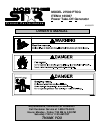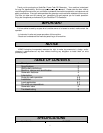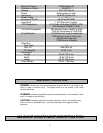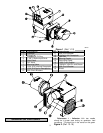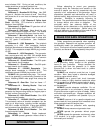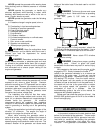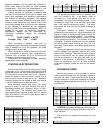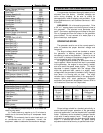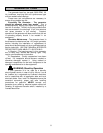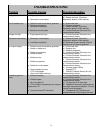
5
NEVER operate the generator while wearing loose
fitting clothing such as neckties, scarves or untucked
shi rts.
NEVER operate the generator, or handle any
electrical equipment while standing in water, while
barefoot, while hands are wet or while in the rain or
snow. Electric shock may result.
NEVER operate the generator under the following
conditions:
A. Excessive change in engine speed, slow or
fast.
B. Overheating in load connecting devices.
C. Sparking or arcs from generator.
D. Loss of electrical output.
E. Damaged receptacles.
F. Engine misfire.
G. Excessive vibration.
H. Enclosed compartments, or confined areas.
I. Flame or smoke.
J. Rain, snow or wet conditions.
K. Operator non-attendance.
L. Without proper guarding in place.
WARNING Keep fire extinguisher close
by your generator and be familiar with how to use it.
Consult your local fire department for correct
extinguisher type.
DANGER Remember, exhaust fumes are
deadly carbon monoxide, a poisonous gas and must
be vented to the outside where there are no people.
Cooling air of sufficient amounts must be brought in
and exhausted out to ensure proper cooling of the
engine and generator.
INSTALLATION
Choose a location where the generator will not be
exposed to rain, snow or direct sunlight. Common
places for mounting your PTO generator are to a trailer
or a cement slab. However you choose to mount the
generator, make sure it can get as close to the load as
possible. This will make using the generator more
convenient and reduce voltage drop.
The installation site must be free from water,
moisture, or dust. Foreign matters, such as dust, dirt,
sand, lint, or abrasive materials can cause damage if
allowed inside the generator. All electrical
components should be protected from excessive
moisture or the insulation system will deteriorate and
result in grounding or shorting out of the generating
sy ste m.
Design the application to minimize the angle of the
driveline, 15° maximum. The smaller the angle of
operation, the longer the driveline will last.
When trailer mounting the generator select a
trailer that is wide enough to withstand the torque of
start-up and loading torque. Wheels that are not
spaced properly could cause the trailer to tip over. The
constant vibration of the generator can cause metal
fatigue of the trailer base if the steel used is not thick
enough.
DANGER Trailer may tip over and cause
serious injury or death. Never stand near an operating
PTO generator.
Use four, grade 5, 5/8” bolts to mount
generator.
After the generator is firmly mounted , attach the
PTO driveline to the generator then the tractor. Use a
synchronized PTO driveline rated at 48 HP minimum.
DANGER Never attach PTO driveline
while tractor is running.
DANGER Always have proper guarding
of rotating parts. Failure to guard the power
transm i ssio n m ech an ism s m ay resul t in se ri ous inj ury
or death.
While seated on the tractor and the engine at idle,
engage the PTO. Slowly increase the throttle until the
needle in the generator voltmeter is at or above the
black line in the green area. A load can now be
applied to the generator. Remember to stay clear of
the rotating PTO driveline. From the tractor seat re-
adjust the speed until the needle on the generator
voltmeter is close to the black line in the green area. If
the needle will not rise to the green area no matter
what the engine speed, the generator is either
overloaded or there is a problem. Use the
troubleshooting guide at the end of the manual for
assistance with possible problems.
Before each use check the gear box oil level. Use
80W-90 SAE synthetic gear oil and fill to the middle of
the oil level sight plug.
LOAD APPLICATION
It is important to determine the total electrical load
before it is connected to the generator. The two major
factors in determining the life of a generator head are:
heat build up, caused by overloading the generator
and corrosive contaminants, that attack the wiring
insulation. If the generator is overloaded, the wires
00506



